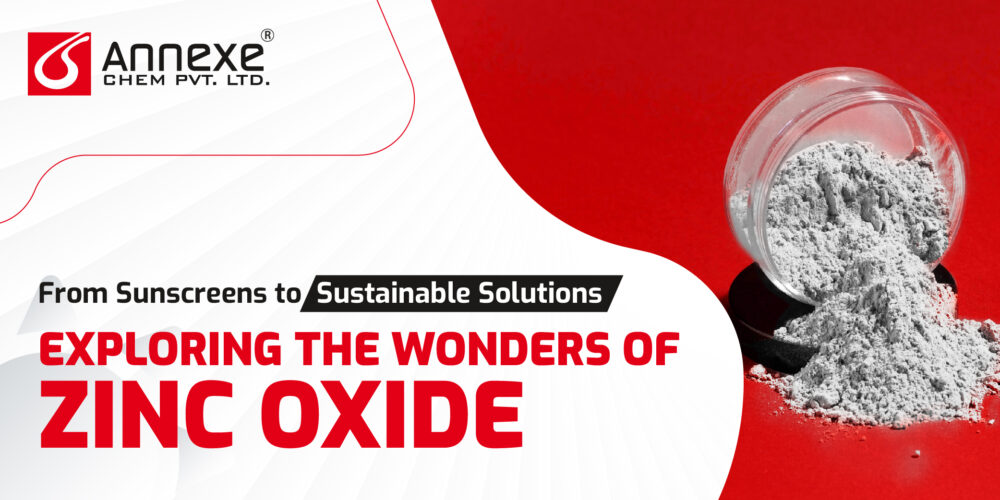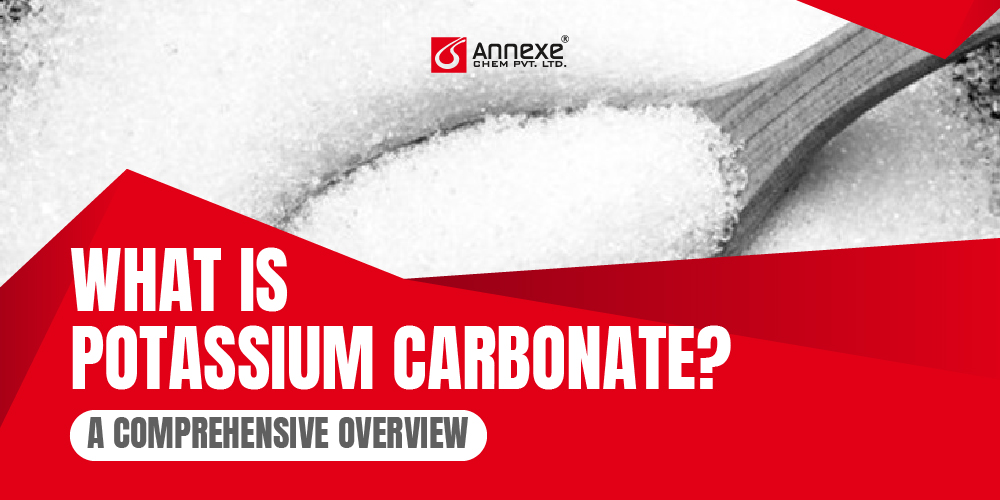Discover Zinc Oxide: From Sunscreens to Sustainability
From Sunscreens to Sustainable Solutions: Exploring the Wonders of Zinc Oxide

- March 19, 2024
- By Akshita Patel
Zinc Oxide stands tall as a versatile and indispensable compound. From its remarkable properties to its diverse range of uses across various sectors, Zinc Oxide has solidified its place as a cornerstone in numerous industries.
Chemical Composition and Structure:
Zinc Oxide, represented by the chemical formula ZnO, is a white, powdery compound. It consists of zinc ions (Zn²⁺) and oxide ions (O²⁻) arranged in a crystalline lattice structure. This arrangement gives Zinc Oxide its characteristic properties such as high stability, low solubility in water, and excellent electrical conductivity.
Physical Properties:
Physically, Zinc Oxide appears as a fine white powder with a hexagonal crystal structure. It is insoluble in water and soluble in acids and alkaline solutions. With a wide bandgap of approximately 3.3 eV, Zinc Oxide exhibits semiconducting properties, making it valuable in various electronic applications.
Historical Significance:
The use of Zinc Oxide dates back centuries, with historical records tracing its utilization in medicinal ointments, pigments, and even as a component in glassmaking during ancient times. Over the years, advancements in chemical synthesis and manufacturing processes have further expanded its applications, propelling Zinc Oxide into the forefront of modern technology.
Applications of Zinc Oxide
Zinc Oxide’s wide-ranging applications underscore its importance in diverse industries, where its unique properties contribute to product performance, durability, and safety. From protecting our skin from the sun’s harmful rays to enhancing the strength and resilience of rubber products, Zinc Oxide continues to play a pivotal role in shaping our modern world.
1. Sunscreen and Skincare Products: In recent years, Zinc Oxide has become a cornerstone ingredient in sunscreen and skincare products. Its ability to effectively block UVA and UVB rays makes it a preferred choice for sun protection. Unlike chemical sunscreen agents that absorb UV radiation, Zinc Oxide acts as a physical barrier, reflecting and scattering the sun’s harmful rays away from the skin. This not only provides broad-spectrum protection but also reduces the risk of skin damage and premature aging. Moreover, Zinc Oxide is gentle on the skin, making it suitable for sensitive skin types and minimizing the risk of irritation or allergic reactions.
2. Rubber and Tire Manufacturing: Zinc Oxide plays a crucial role in the rubber industry, particularly in tire manufacturing. It serves as an essential ingredient in rubber compounding, where it acts as a reinforcing agent, improving the mechanical properties and durability of rubber compounds. Zinc Oxide also enhances the bonding between rubber molecules and other additives, resulting in stronger and more resilient rubber products. Additionally, Zinc Oxide helps to protect rubber materials from degradation caused by exposure to UV radiation, heat, and oxidative processes, thereby extending the lifespan of tires and other rubber products.
3. Ceramics and Glass Industries: In the ceramics and glass industries, Zinc Oxide finds widespread use as a fluxing agent and opacifier. As a flux, Zinc Oxide lowers the melting point of ceramic materials, facilitating the fusion of different components and promoting the formation of a dense, uniform ceramic body during firing. It improves the workability and strength of ceramic products, making them more suitable for a wide range of applications, from tableware to industrial components. Additionally, Zinc Oxide acts as an opacifier in glass formulations, imparting opacity and brightness to glass products while reducing light transmission.
4. Pharmaceuticals: Zinc Oxide plays a crucial role in the pharmaceutical industry, where it is utilized in various medicinal formulations and topical ointments. Its antiseptic and astringent properties make it an effective ingredient in antiseptic creams, lotions, and powders for treating minor skin irritations, cuts, and burns. Zinc Oxide also exhibits anti-inflammatory properties, making it beneficial for soothing and protecting irritated or inflamed skin conditions such as diaper rash and eczema. Moreover, Zinc Oxide nanoparticles have garnered attention for their potential applications in targeted drug delivery systems and biomedical imaging techniques.
5. Textiles and Textile Manufacturing: In the textile industry, Zinc Oxide is employed for its multifunctional properties, including UV protection, antimicrobial activity, and moisture management. Fabric treated with Zinc Oxide nanoparticles or coatings offers enhanced UV protection, shielding the skin from harmful UV radiation and reducing the risk of sunburn and skin cancer. Furthermore, Zinc Oxide exhibits antimicrobial properties, inhibiting the growth of odor-causing bacteria and fungi on textiles, thereby improving hygiene and prolonging the freshness of textile products. Additionally, Zinc Oxide nanoparticles can be incorporated into textile fibers or coatings to impart water-repellent and stain-resistant properties, enhancing the durability and performance of textiles in various applications, from outdoor apparel to medical textiles.

The Role of Zinc Oxide in Sunscreens
Zinc Oxide is a powerhouse in sunscreens, offering robust protection against harmful UV radiation.
- UV Protection Mechanism: Zinc Oxide acts as a physical barrier, reflecting and scattering UVA and UVB rays away from the skin. Its broad-spectrum protection shields against sunburn and premature aging.
- Advantages Over Other Ingredients: Unlike some chemical sunscreens, Zinc Oxide is gentle on the skin, providing immediate and long-lasting protection without the risk of irritation. It’s also eco-friendly and doesn’t harm marine life or coral reefs.
- Environmental and Health Considerations: Zinc Oxide’s non-toxic, biodegradable nature makes it a safer choice for both humans and the environment. Its use addresses growing concerns about the impact of chemical sunscreens on ecosystems and human health.
Innovations & Research Related To Zinc Oxide
- Recent Advancements in Zinc Oxide Technology: Nanotechnology has emerged as a key driver of innovation, enabling the synthesis of Zinc Oxide nanoparticles with unique properties and functionalities. These nanoparticles exhibit enhanced optical, electrical, and catalytic properties compared to conventional Zinc Oxide particles, opening up new avenues for applications in electronics, sensors, catalysis, and biomedical fields. Techniques such as sol-gel, hydrothermal, and spray pyrolysis have been refined to achieve precise control over particle size, shape, and surface properties, leading to enhanced performance in areas such as photocatalysis, gas sensing, and drug delivery.
- Emerging Applications: In electronics, Zinc Oxide thin films, and nanostructures are being investigated for use in transparent conductive coatings, thin-film transistors, solar cells, and light-emitting diodes (LEDs). In the biomedical field, Zinc Oxide nanoparticles hold potential for applications in drug delivery, bioimaging, tissue engineering, and cancer therapy. Their biocompatibility, tunable size, and surface chemistry enable precise control over drug release kinetics, targeted delivery to specific cells or tissues, and imaging of biological structures with high resolution. Zinc Oxide nanoparticles are being explored for environmental remediation applications, including photocatalytic degradation of pollutants, water purification, and air filtration. Their ability to generate reactive oxygen species under UV irradiation enables the efficient degradation of organic pollutants and pathogens, offering a sustainable solution for addressing environmental challenges.
- Future Prospects: Advances in materials synthesis, characterization techniques, and computational modeling are expected to drive further innovation and enable the development of novel Zinc Oxide-based materials and devices with enhanced performance, functionality, and sustainability. Moreover, interdisciplinary collaborations between researchers from academia, industry, and government agencies are essential for accelerating the translation of Zinc Oxide research into practical applications and commercial products. By harnessing the collective expertise and resources of various stakeholders, we can harness the power of Zinc Oxide to address pressing societal challenges, improve quality of life, and create a more sustainable future.
The rapid pace of innovation and research in Zinc Oxide technology holds promise for revolutionizing various industries and addressing global challenges. By leveraging the unique properties and versatility of Zinc Oxide, we can unlock new opportunities for technological advancement, economic growth, and environmental sustainability.
In conclusion, Zinc Oxide stands as a remarkable compound with a myriad of applications and a promising future in various industries. Its versatility, safety, and effectiveness make it an invaluable ingredient in products ranging from sunscreens to electronics and beyond. At Annexe Chem Pvt. Ltd., we’ve been a leading Zinc Oxide manufacturer in India. With a focus on manufacturing a wide range of fine chemicals, we’ve garnered market awareness and built a strong reputation for delivering quality products tailored to our customers’ needs.
Our commitment to quality is evident in every aspect of our operations, from manufacturing to packaging. We utilize advanced technology and adhere to strict FDA-GMP standards to ensure the highest quality standards are met. Our products, available in various grades to meet different specifications, are competitively priced and delivered timely through a well-established distribution network.
As we continue to innovate and adapt to evolving market demands, we remain committed to providing exceptional products and service to our valued customers. With Zinc Oxide and other fine chemicals at the core of our offerings, we look forward to contributing to advancements in technology, healthcare, and beyond, while upholding the highest standards of quality and integrity.

Akshita Patel
As an advocate for sustainability, Akshita is committed to driving positive change within the chemical industry. She actively seeks out environmentally friendly solutions and promotes the adoption of sustainable practices. Akshita believes that a balance between economic growth and ecological responsibility is crucial for the industry's long-term success. She is dedicated to finding innovative ways to minimize environmental impact while maximizing efficiency and profitability.
Related Blogs

- April 15, 2025
- By Akshita Patel
The Ultimate Guide to Di Sodium.
Ever wondered what keeps your favorite soft drinks fizzy, your cheese perfectly creamy, or even helps.

- December 23, 2024
- By Akshita Patel
What is Potassium Carbonate? A Comprehensive.
Did you know that a single compound can shape the glass in your windows, soften the.



